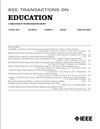Leveraging Design Thinking to Enhance Engineering Teaching: An Operational Model
IF 2
2区 工程技术
Q2 EDUCATION, SCIENTIFIC DISCIPLINES
引用次数: 0
Abstract
Contribution: The proposed operational model offers a detailed framework for understanding the complexities of design thinking. It helps instructors evaluate each stage, promoting the development of high-quality designs. This model emphasizes the link between the various stages and the final design quality, steering students toward achieving outstanding results. Background: Design thinking benefits students across almost all majors by promoting critical thinking, creativity, and teamwork. It places a strong emphasis on the user’s needs and involves testing and refining prototypes with empathy for the user. While easy to grasp, its practical application poses complex challenges, particularly in engineering and science education. Intended Outcomes: This study examines the challenges of teaching design thinking and proposes an operational model to represent the design process. Application Design: The model incorporates a “spring system” to demonstrate potential variations in the design process, including the number of user-centered design (UCD) methods used, the size of the problem/solution space, the difficulty or resistance to transitioning between activities, and time spent on each activity. Findings: Two projects illustrate the use of the model. Using the proposed metrics, the design process can be established, and the operational model can control the learning process while enhancing the consistency and quality of the design outcome. Future empirical research should validate the model’s effectiveness, address biases, and foster critical thinking and diverse perspectives within student teams.运用设计思维加强工程教学:一种运作模式
贡献:建议的操作模型为理解设计思维的复杂性提供了一个详细的框架。它帮助教师评估每个阶段,促进高质量设计的发展。这种模式强调各个阶段和最终设计质量之间的联系,引导学生取得优异的成绩。背景:设计思维对几乎所有专业的学生都有好处,它能促进批判性思维、创造力和团队合作。它非常强调用户的需求,并涉及测试和改进原型,以同情用户。虽然易于掌握,但它的实际应用提出了复杂的挑战,特别是在工程和科学教育中。预期结果:本研究考察了教学设计思维的挑战,并提出了一个代表设计过程的操作模型。应用程序设计:该模型包含一个“弹簧系统”来演示设计过程中的潜在变化,包括所使用的以用户为中心的设计(UCD)方法的数量、问题/解决方案空间的大小、活动之间转换的难度或阻力,以及在每个活动上花费的时间。发现:两个项目说明了该模型的使用。使用提出的度量,可以建立设计过程,操作模型可以控制学习过程,同时提高设计结果的一致性和质量。未来的实证研究应该验证模型的有效性,解决偏见,并在学生团队中培养批判性思维和多样化的观点。
本文章由计算机程序翻译,如有差异,请以英文原文为准。
求助全文
约1分钟内获得全文
求助全文
来源期刊

IEEE Transactions on Education
工程技术-工程:电子与电气
CiteScore
5.80
自引率
7.70%
发文量
90
审稿时长
1 months
期刊介绍:
The IEEE Transactions on Education (ToE) publishes significant and original scholarly contributions to education in electrical and electronics engineering, computer engineering, computer science, and other fields within the scope of interest of IEEE. Contributions must address discovery, integration, and/or application of knowledge in education in these fields. Articles must support contributions and assertions with compelling evidence and provide explicit, transparent descriptions of the processes through which the evidence is collected, analyzed, and interpreted. While characteristics of compelling evidence cannot be described to address every conceivable situation, generally assessment of the work being reported must go beyond student self-report and attitudinal data.
 求助内容:
求助内容: 应助结果提醒方式:
应助结果提醒方式:


